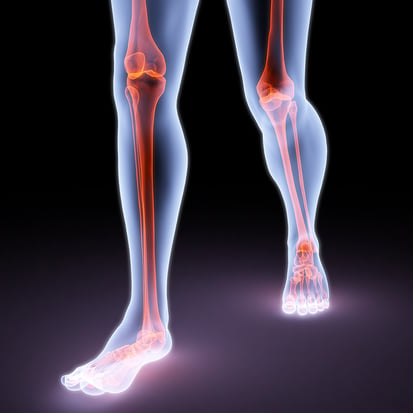Work-related musculoskeletal disorders (WMSDs) occur in the workplace when workers stand for long periods every day. This type of pain is sometimes referred to as lower ligament WMSD. On average, workers suffering from this type of WMSD are off work eight days per year due to the pain, which can also cost employers millions of dollars in lost productivity.
 Nurses, grocery store checkers, chefs, and food service workers as well as workers in industrial locations are most susceptible to lower ligament WMSD, experiencing pain in their feet, ankles, knees, and legs. This is because these workers are often standing as much as 12 hours per day. Making matters worse, they are usually standing in the same area on hard surfaces. These hard surfaces provide little or no bounce (“give”) to make standing a bit more comfortable and less fatiguing.
Nurses, grocery store checkers, chefs, and food service workers as well as workers in industrial locations are most susceptible to lower ligament WMSD, experiencing pain in their feet, ankles, knees, and legs. This is because these workers are often standing as much as 12 hours per day. Making matters worse, they are usually standing in the same area on hard surfaces. These hard surfaces provide little or no bounce (“give”) to make standing a bit more comfortable and less fatiguing.
The employer has a crucial role in helping employees deal with lower ligament WMSD. The best option is to install what is called anti-fatigue mats. These mats are specially engineered to provide both a cushion and a bounce while standing. This increases body movement, disperses the worker’s weight more evenly over the surface, and helps improve blood circulation. This helps prevent the occurrence and severity of WMSDs, injuries, and worker fatigue, which helps improve worker productivity.
For many years, floor mat manufacturers attempted to produce anti-fatigue mats by merely adding more foam to their current line of mats. Alternatively, they would use hardened rubber and simply glue it to a sponge or foam base. In both situations, the foam and the sponge would flatten over time, and the cushion and bounce necessary to reduce or prevent WMSDs would disappear.
That all changed with the introduction of Zedlan. This patented technology is recognized as the matting industry’s softest, most comfortable, and most durable foam, perfect for use in anti-fatigue mats in all types of settings. Some studies indicate it provides three times the bounce of similar mats without Zedlan technology. The result: anti-fatigue mats with Zedlan technology provide greater stimulation to muscles and improve blood flow, helping to reduce pain, fatigue, and WMSDs.
For more information on mats that help reduce pain and improve worker productivity, contact Crown Matting Technologies at 800-628-5463 or send us an email.
Comments